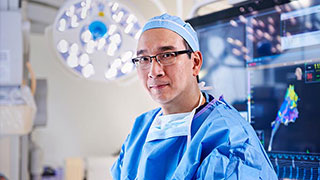Focused Treatment for Real Results
Dystonia is the third most common movement disorder, characterized by muscles contracting excessively and involuntarily. It is not a neurodegenerative disorder like Parkinson’s disease or Huntington’s disease. However, like those conditions, dystonia arises from the same circuitry and region in the brain.
People with dystonia experience abnormal posture, in which part or all of the body might be bent in a contorted position, restricting movements. The muscle contractions can be painful, and some patients might also have a tremor or incoordination.
The five main types of dystonia are classified by the part of the body they affect:
- Generalized dystonia affects most or all of the body and frequently involves the back and trunk.
- Focal dystonia is localized to a specific part of the body, such as the hand or eyes. Cervical dystonia, blepharospasm (involuntary muscle spasms and contractions of the muscles around the eyes), laryngeal dystonia, and writer's cramp are all examples of focal dystonia.
- Multifocal dystonia affects two or more regions of the body that are not connected to each other, such as the left arm and left leg.
- Segmental dystonia affects two or more adjacent parts of the body. Cranial dystonia (involuntary contractions of the muscles of the jaw and tongue) and blepharospasm are two examples of segmental dystonia.
- Hemidystonia affects one entire side of the body.
Dystonia can also be classified according to age at onset:
- Early-onset generalized dystonia involves patients who develop symptoms prior to age 30. It’s characterized by twisted limbs. The younger the patient is at onset, the higher the likelihood that the dystonia will spread to other areas.
- Adult-onset dystonia symptoms typically appear in patients between 40 and 60 years of age. In most cases, symptoms start in the upper body and generally don’t spread.
Our Services for Dystonia
The Movement Disorders team at UT Southwestern includes physicians who have advanced training in movement disorders and the management of dystonia. We treat a large number of patients with dystonia, and that experience translates into better care for our patients.
Because dystonia has many different symptoms, it’s often misdiagnosed. We base a dystonia diagnosis on a clinical evaluation, medical history, blood or urine test, and/or brain MRI. Learn how we evaluate patients for dystonia.
There is no standard treatment for dystonia. Instead, each patient’s treatment options are based on his or her symptoms. Treatments might include:
- Deep brain stimulation
- Injections of a botulinum toxin (for example, Botox®)
- Muscle relaxant medication
- Occupational, speech, and physical therapy
- Surgery
Learn more about these treatments.
Clinical Research
UT Southwestern is at the forefront of new and emerging clinical research on dystonia, including collaborations that aim to advance and provide new treatment options for people with this disorder.




